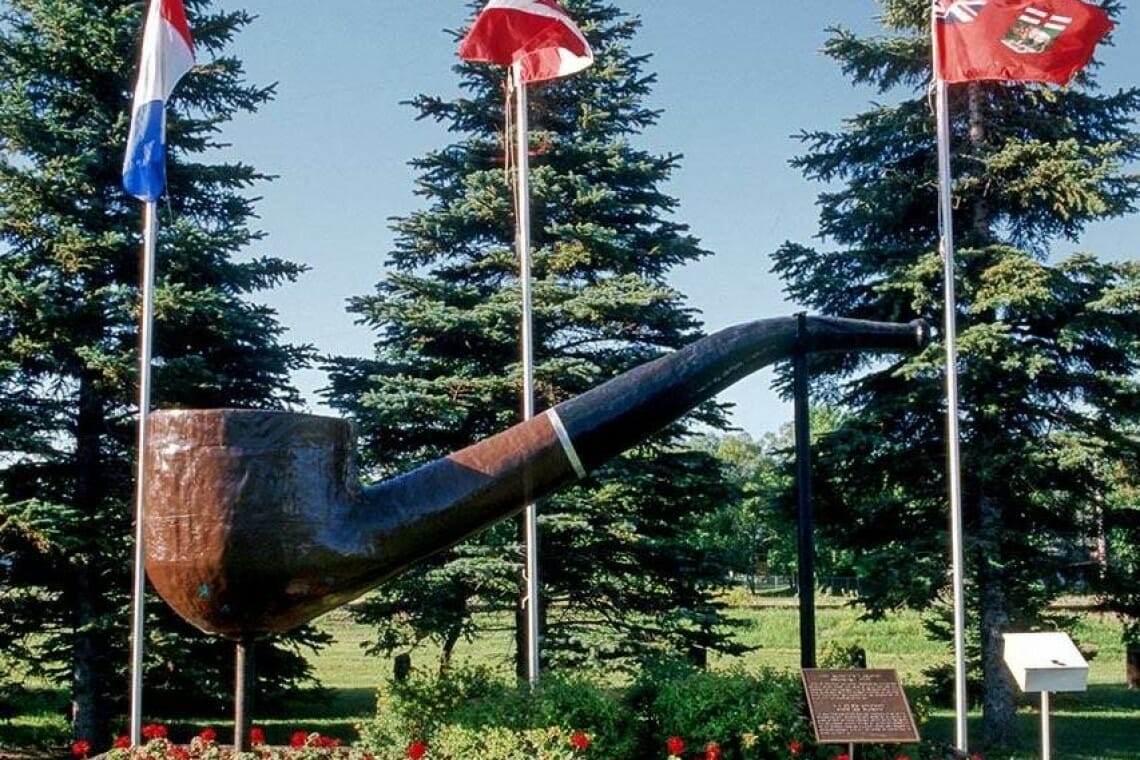Culture, Museums and historic sites, Outdoor
Rural Manitoba is well-known for the wide range of roadside attractions dotted along its highways. There are over 60 wacky attractions spread throughout the province, including in our bilingual municipalities! From a giant dairy cow in La Broquerie to the (second) biggest pipe in the world, here’s the story behind some of our favourite roadside attractions. We challenge you to find them all this summer!
La Broquerie – Brisette the Cow
Overlooking La Broquerie’s Main Street is a giant cow named Brisette, after the village’s nickname. The statue was erected in 1983 to commemorate the centennial of the village and to pay homage to the significance of the dairy industry to the region’s economy. It’s an adorable landmark and a great spot to take some silly photos with the family.
RM of Taché – Centre of Canada
Did you know: the geographical centre of Canada is located in the Rural Municipality of Taché, just 30 km away from Winnipeg? Once you’re there, you can enjoy the place marker, a flower garden and – recently added – a giant Adirondack chair! It’s a great spot to relax and to reflect on our country’s natural beauty.
St. Claude – Pipe
St. Claude is home to the second largest tobacco pipe in the world. Fun fact: the biggest tobacco pipe in the world is located in the village in France that gave its name to St. Claude, MB and where the first settlers of the village originally came from. The monument is meant to commemorate the French origins of the village’s first settlers, where the manufacture of tobacco pipes is a key industry.
St. Malo – Deer
For many residents of the community, when you talk about St. Malo, you also talk about deer. Funny story: the reason behind this deer statue is a program led by residents of St. Malo in the 1980s that aimed to bring deer to St. Malo from Winnipeg, because there were too many deer at the time in Winnipeg. In fact, this local initiative ended up being the first and only of its kind to succeed in Canada, which makes the statue an emblem of the welcoming and collaborative feel of the community!
Roseisle – Rose
What a surprise — a giant rose in Roseisle! It was actually a very specific rose that gave its name to the village of Roseisle, located in the Rural Municipality of Dufferin. Legend has it that the first inhabitants of the region were so struck by a small rose that was blooming after heavy rains that they decided to name the nascent village Roseisle. Today, the monument pays tribute to the first pioneers of the region and their resilience.
St. Joseph – BeanToday, St. Joseph is a prosperous village that is home to the largest wind turbine park in the province. But did you know that it was one of the first settlements populated by Francophones in southern Manitoba? Most of the first settlers in the region were farmers – and this agricultural heritage still looms large in the village. One sign of the village’s agricultural roots is a giant bean located at the entrance to St. Joseph, which alludes to St. Joseph’s moniker as “bean town”. Our recommendation: make a stop by the St. Joseph Museum’s boutique, where you can find a wide range of beans and legumes harvested in the village for sale. They make perfect ingredients for a delicious soup!



A visit to Manitoba means travelling through Treaty 1, 2, 3, 4, and 5 territory and communities signatory to Treaties 6 and 10, the original lands of the Anishinaabeg, Anish-Ininiwak, Dakota, Dené, Iiniwak, and Nehethowuk and the homeland of the Métis Nation. Its ongoing existence is thanks to these ancestors and their present day relatives who continue to love and care for the land.